Ata-ul-Haye Nasir, Ahmadiyya Archive & Research Centre
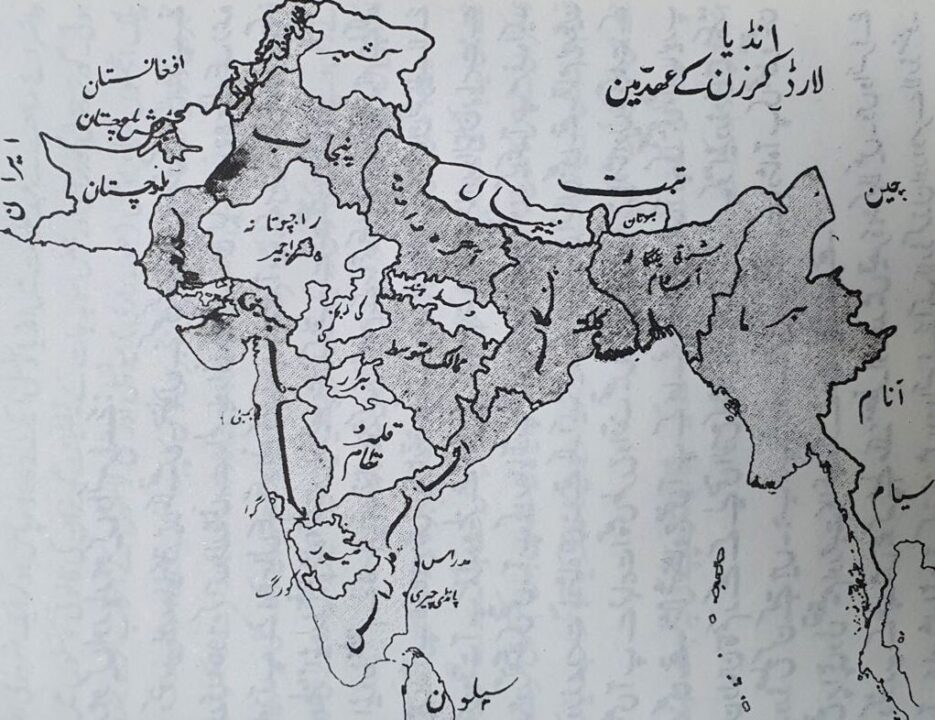
Witnessing their failure in various attempts to sabotage the peaceful movement for the oppressed Kashmiri Muslims, the Ahrar hatched a vicious plan to initiate a much stronger and more dangerous campaign against Ahmadiyyat at the beginning of 1933.
Ahrar’s anti-Ahmadiyya campaign intensifies
The Ahmadis were at the forefront of advocating Muslim rights, which “was too much for the Ahrars, who were determined that the Ahmadis would not steal a march on them.” Hence, “Qadian, the Ahmadi headquarters, became the prime focus of the Ahrar’s assault. The Ahrar leadership had already instituted the Dawat-o-Irshad on 4 March 1933 with the purpose of raising funds as well as a volunteer corps of 100,000 men to combat the growing influence of the Ahmadiya. While this grandiose scheme never came to fruition, the Ahrar persisted in their anti-Ahmadiya activities.” Importantly, the “animosity towards the Ahmadis provided the glue for a movement that otherwise might have rapidly disintegrated.” (“The Pre-History of Religious Exclusionism in Contemporary Pakistan: ‘Khatam-e-Nubuwwat’ 1889–1953.” Modern Asian Studies 49, no. 6 (2015): 1840–74. www.jstor.org/stable/24734820.)
Chaudhry Afzal Haq, known as the Mufakkir-e-Ahrar, has stated that their opposition to Ahmadiyyat “was due to both political and religious reasons,” and “it was impossible to imagine about freedom [of India] without minimising the influence of this Jamaat.” (Tarikh-e-Ahrar, Maktaba-e-Majlis Ahrar-e-Islam Pakistan, 1968, pp. 178-179)

On 25 February 1936, Mr Metcalfe from the Foreign and Political Department of the Indian Government sent a telegram to Sir Andrew Ryan who was serving as the Envoy Extraordinary and Minister Plenipotentiary in Saudi Arabia, including a “Note recording the history of the Ahrar Movement in India”. In January 1936, the Undersecretary to the Foreign Affairs of Saudi Arabia had inquired about Majlis-e-Ahrar from Sir Andrew Ryan.
The note stated:
“This Majlis lost no opportunity to advertise itself and it was fortunate in securing an ideal stage in the Kashmir agitation of 1931-32. When this died down the Ahrars found their importance diminishing and therefore they turned their attention to fresh fields and at the close of 1933 they embarked on an attack on the Ahmadiya community.” (Coll 6/11 ‘Hejaz-Nejd Affairs: Economic Development in the Hejaz’ [32r] (64/504), British Library: India Office Records and Private Papers, IOR/L/PS/12/2077, in Qatar Digital Library, www.qdl.qa [accessed 22 September 2023])
This note also highlights the fact that certain political sections of the Sikh and Hindu communities had been supporting the Ahrar in their campaign against Ahmadiyyat. (Ibid)
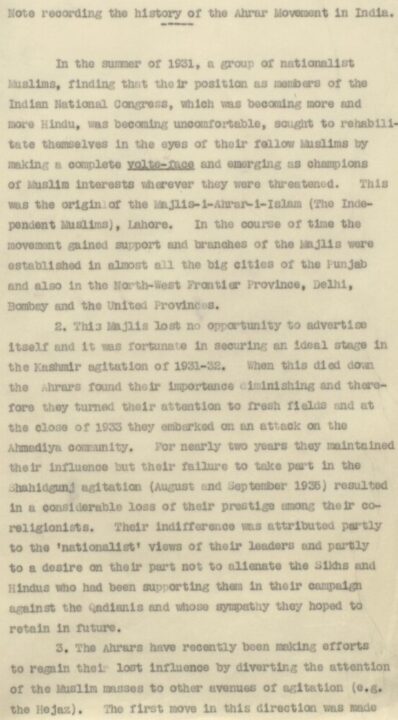
Due to their violent actions, the Ahrar were “shunned by Sheikh Abdullah and other volunteers. However, the Ahrars always claimed themselves as the ultimate saviors of Kashmir. They condemned the Ahmadiyyas as kafirs. They transformed the Kashmir agitation into a holy war against the Ahmadiyyas by launching an agitation against them in Punjab and Kashmir.” Moreover, “the pro-Ahrar newspapers referred to Ahmadiyyas and British intrigues in collaboration with Maharaja Hari Singh.” Further, “Sheikh Abdullah and his followers were alleged to be followers of the Ahmadiyyas.” (Social Scientist, Vol. 49, March-April 2021, p. 63)
In this regard, C. Bilqees Taseer states:
“Because of the fact that the first Chairman of the All India Kashmir Committee, Mirza Bashiruddin Mahmud Ahmed[ra] and some other members, including Sir Zafrullah Khan[ra] were Ahmedis, Mian Amiruddin said in an interview with me in Lahore in January, 1984 that he asked Khawaja Saaduddin Shawl of Srinagar to bring Sheikh Abdullah, in September, 1932, to a pre-arranged meeting place at a restaurant near the Jhelum river, where Sheikh Muhammad Sadiq of Amritsar was also present, and Sheikh Abdullah was asked to prepare a statement for the press to the effect that he was not a member of either the Qadiani or the Lahore group of the Ahmedis and this statement was published in all the Lahore newspapers. Mian Amiruddin added that in Srinagar, where Mirwaiz Muhammad Yusuf Shah had been the first to make the same accusation against Sheikh Abdullah he was required to give a similar declaration in a public meeting. The fact that at this time he kept a small beard helped to lend credence to the rumour of his being an Ahmedi, but he was actually a Hanifi-Sunni. […]
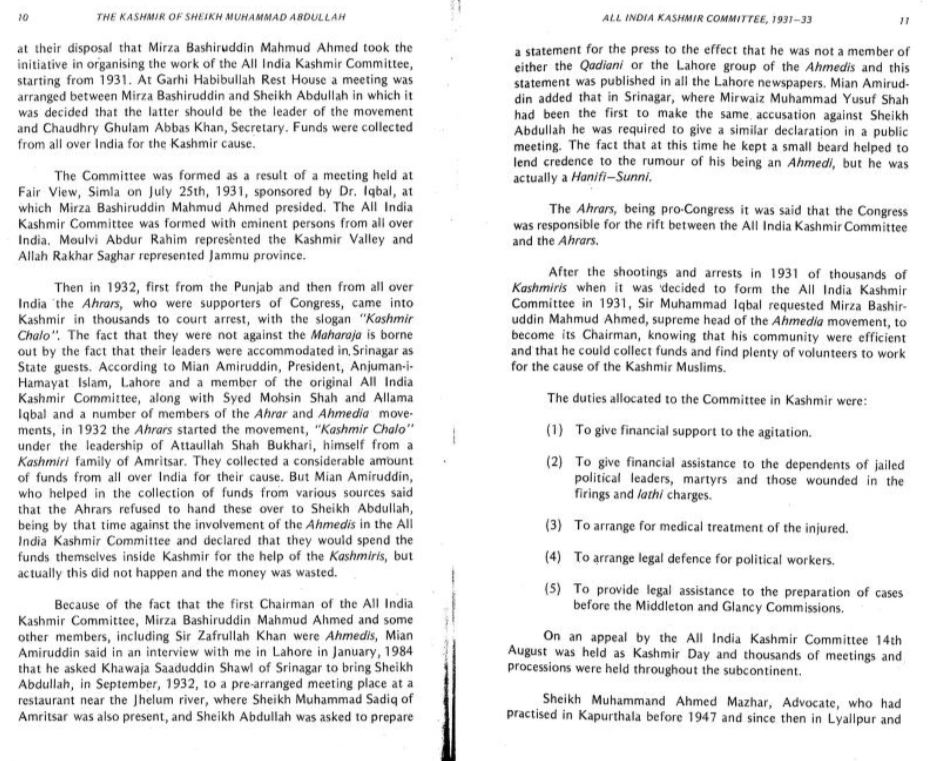
“Because of being at the head of the relief and rehabilitation work being done in the years 1931-33 for the Kashmiris affected by the July, 1931 uprisings Sheikh Abdullah had a fair amount of correspondence with Mirza Bashiruddin Mahmud Ahmed[ra], particularly regarding details of expenditure of funds entrusted to him. It was after the two meetings, one with Mian Amiruddin, one in a public meeting in Srinagar regarding allegations about his own faith that he wrote on 22-10-32 to Mirza Bashiruddin Mahmud Ahmed[ra] (in Urdu):
“‘I have been asked about my faith. My God knows what I am, who I am. I know my God is fully aware about my faith and my mission for the liberation of the Kashmiris from the Dogra raj.’
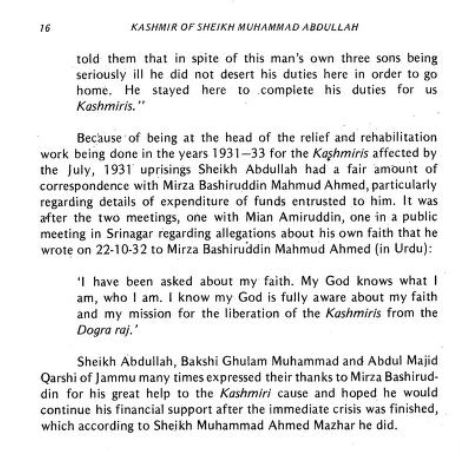
“Sheikh Abdullah, Bakshi Ghulam Muhammad and Abdul Majid Qarshi of Jammu many times expressed their thanks to Mirza Bashiruddin[ra] for his great help to the Kashmiri cause and hoped he would continue his financial support after the immediate crisis was finished, which according to Sheikh Muhammad Ahmed Mazhar he did.” (The Kashmir of Sheikh Muhammad Abdullah, Ferozsons Pvt. Ltd, Lahore, 1986, pp. 10-11 and 16)
It was unfortunate that the Ahrar’s focus and emphasis was completely on their opposition to Ahmadiyyat. (Encyclopedia Pakistanica, Al Faisal, Lahore, p. 164)
‘Endure these trials with patience’: Hazrat Musleh-e-Maud’sra advice to Ahmadis
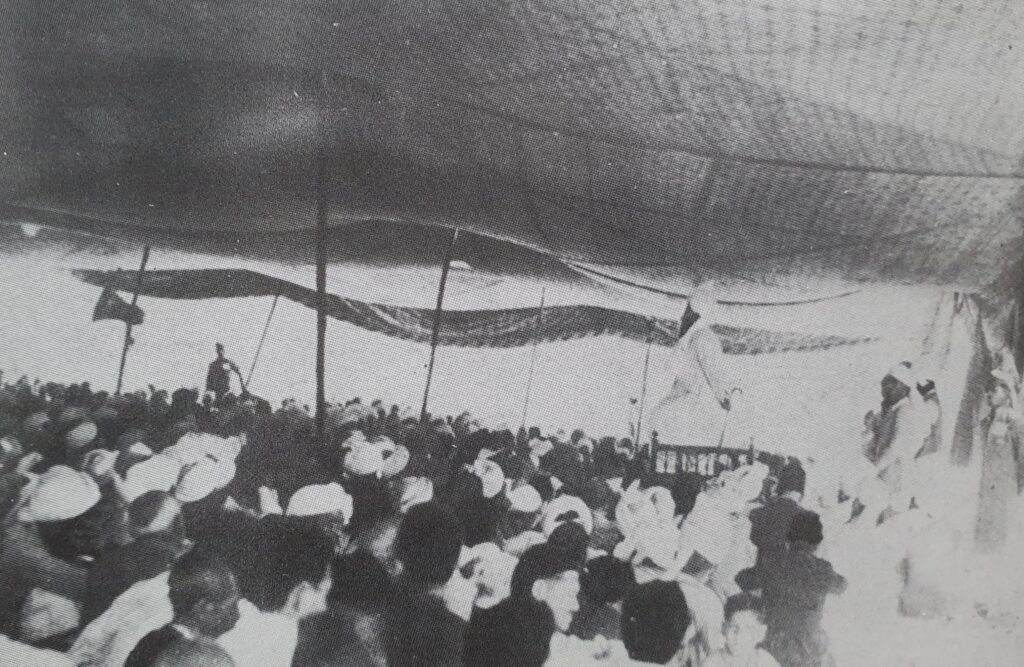
While the Ahrar were intensifying their opposition against Ahmadis, Hazrat Musleh-e-Maudra advised Ahmadis to endure these hardships with patience. During his Friday Sermon on 3 March 1933, Huzoorra mentioned his lecture which he delivered at a gathering in Sialkot, in 1931, where Ahrar attacked with stones resulting in many injuries to Ahmadis and three to four stones hit Huzoor’sra hands as well:
“It is our duty to endure these trials with patience, like the [Holy Prophet’ssa] Companionsra had endured all hardships with patience and perseverance. […] You ought not to be a coward, but rather, be courageous, however, you must act in accordance with the pathway taught to you by God. You are required to preach the Word of God which has descended from Him, and propagate the teachings which you have learnt through the Promised Messiahas. […]
“You are required to pay attention to tabligh, and endure the hardships with patience. If the opponents [wish to] kill you, you are required to preach with even more passion. If they abuse you, pray for them. If you exhibit such an example, a great revolution will occur within a year. […] You must remember that falsehood does not stand for long. It is stated in the Holy Quran:
جَآءَ الۡحَقُّ وَزَہَقَ الۡبَاطِلُ ؕ اِنَّ الۡبَاطِلَ کَانَ زَہُوۡقًا
“‘Truth has come and falsehood has vanished away. Falsehood does indeed vanish away [fast].’ (Surah Bani Israil, Ch. 17: V. 82)
“Thus, no doubt, they will mislead people for a short period of time, but falsehood always vanishes away, and the truth always prevails. Hence, during these days, carry out tabligh with greater zeal.” (Khutbat-e-Mahmud, Vol. 14, pp. 33-41)
Ahrar behind the unrest within the Kashmir Committee
While the movement for the rights of oppressed Kashmiris was achieving great success under the leadership of Hazrat Mirza Bashir-ud-Din Mahmud Ahmadra, through peaceful methods, the Ahrar created unrest within the Kashmir Committee. The Ahrar left no stone unturned to create suspicion within the hearts of Indian Muslims towards this Committee, and they would also declare certain Muslim leaders to be Ahmadi or well-wishers of Ahmadis, such as Khwaja Hassan Nizami Sahib, Maulvi Muhammad Ismail Ghaznavi, Syed Habib Sahib of Siasat and Maulana Ghulam Rasul Sahib Mehr. Moreover, they also took certain steps to undermine the efforts of local Kashmiri leaders who were in close relations with the Kashmir Committee.
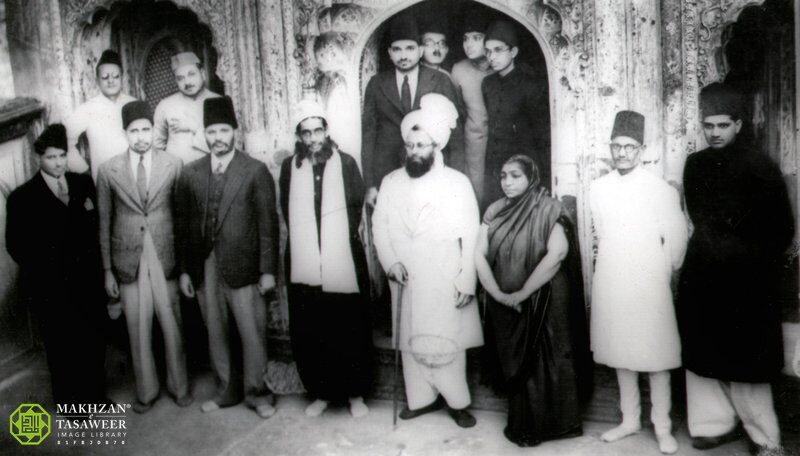
Chaudhry Afzal Haq states that upon the establishment of the Kashmir Committee, Ahrar leaders went to Lahore and found Maulvi Dawood Ghaznavi a bit worried. Upon asking, he said that an Ahmadi Muslim being the president of the Kashmir Committee “would be detrimental for the Muslims; thus, I wish to meet the ulema of the city and then to make an announcement against their leadership [Hazrat Mirza Bashir-ud-Din Mahmud Ahmadra].” (Tarikh-e-Ahrar, Maktaba-e-Majlis Ahrar-e-Islam Pakistan, 1968, pp. 94-95)
He further states that “the same day or the next, there was a jalsa of the dignitaries of the city at the Muhammadan Hall, presided over by Allama Iqbal, where the disturbing situation of Kashmir was discussed. Maulana Mazhar Ali, probably Maulana Dawood Ghaznavi as well, and I went to the Muhammadan Hall with the aim of getting the support of all those [dignitaries] in favour of the Ahrar against the Kashmir Committee of Mirza Bashir[ra]. The attendees belonged to the elite class, who would express their disinterest even upon hearing the name of Ahrar; however, Dr Sahib [Allama Iqbal] insisted on taking the Ahrar ahead. Anyhow, we succeeded in compelling him to make an announcement in our favour. Now, we had gained a little room, and we just required some more courage to take complete control.” (Ibid, p. 95)
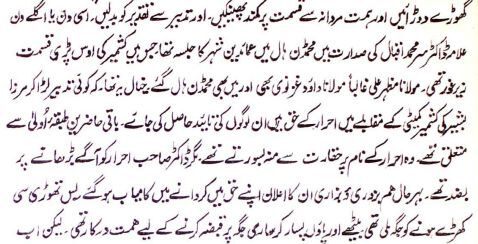
This was the level of their desperation for power. All of these actions taken by Ahrar were clearly against the Muslim interest.
According to Janbaz Mirza, official historian of Majlis-e-Ahrar, some Ahrar leaders had a meeting with Iqbal and asked, “Have you also acknowledged the” Ahmadi “leadership? If so, you would be deemed responsible in front of Allah the Almighty on the Day of Judgement if 3.2 million Muslims in Kashmir converted to” Ahmadiyyat, “following your example.” Moreover, Ahmadis “would have a misguiding impact on other Muslims as well. Therefore, you ought to announce your separation from them.” (Karwan-e-Ahrar, Vol. 1, 1975, Maktabah Tabsarah, Lahore, p. 182)
C. Bilqees Taseer states:
“The Ahrars, being pro-Congress it was said that the Congress was responsible for the rift between the All India Kashmir Committee and the Ahrars.” (The Kashmir of Sheikh Muhammad Abdullah, Ferozsons Pvt. Ltd, Lahore, 1986, p. 10)
Observing this situation, Hazrat Mirza Bashir-ud-Din Mahmud Ahmadra called a session of the Kashmir Committee on 7 May 1933 and resigned from the presidency.
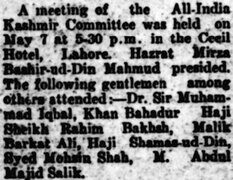
During this meeting, a resolution was passed, which stated:
“This meeting deems it its duty to place on record its genuine and sincere appreciation of the valuable and sincere services rendered by Hazrat Mirza Bashir-ud-Din Sahib Mahmud[ra] to the cause of Kashmiri Mussalmans.
“That in view of the fact that Mirza Bashir-ud-Din Mahmud[ra] has volunteered to resign the Presidency of the Kashmir Committee, this Committee regretfully accepts that resignation.” (The Civil and Military Gazette, 16 May 1933, p. 8)
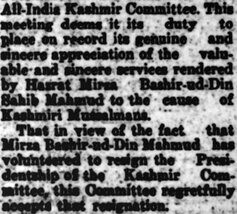
Sheikh Abdullah has also mentioned this sad episode in his autobiography:
“The Ahrar began emphasising that the Kashmir Committee should be vacated from” the Ahmadi members “in order to eradicate the issue of” Ahmadis. Further, a non-Ahmadi Muslim should “be appointed as the president of the Kashmir Committee. […] Consequently, Mirza Mahmud[ra] had to resign from the Committee’s presidency.” (Aatish-e-Chinar, pp. 142-143, Published by Ali Muhammad & Sons, Srinagar, Kashmir)
Mentioning these events, Janbaz Mirza states that after the meeting of Ahrar leaders with Iqbal, a session of the Kashmir Committee was called in Lahore, where “Chaudhry Afzal Haq, Maulana Mazhar Ali Azhar, and Maulana Dawood Ghaznavi attended without any invitation. Since Dr Iqbal was aware of the situation, he used his impact on the” non-Ahmadi “members of the session, separated Bashir-ud-Din Mahmud[ra] from the Kashmir Committee, and took the presidency himself.” (Karwan-e-Ahrar, Vol. 1, 1975, Maktabah Tabsarah, Lahore, pp. 182-183)
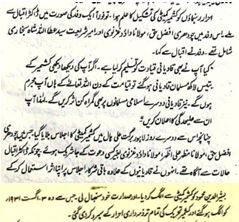
Here, he has intentionally given the false impression that Huzoorra was “removed” from the Kashmir Committee and its presidency, whereas history testifies that since Huzoorra did not want to let the rift escalate further, he himself resigned from the presidency. It also highlights the fact that Huzoorra was in no way ambitious for any worldly or political position, but rather, his sole objective was to help the oppressed people.
Janbaz Mirza added that Iqbal “occupied the presidency, from which he resigned on 3 August 1931, and all responsibilities of the Kashmir movement were handed over to the Ahrar.” (Ibid., p. 183)
Iqbal resigned by stating that the Ahmadi members of the Committee would not be loyal to anyone other than their Imam. Iqbal suggested forming a new Kashmir Committee and that it would not be open to Ahmadis. (Self and Sovereignty: Individual and Community in South Asian Islam Since 1850, Routledge, 2000, p. 364)
Agha Shorish Kashmiri acknowledges that Iqbal “resigned from the Kashmir Committee on the request of the Ahrar.” (Syed Ataullah Shah Bukhari: Sawaneh wa Afkar, by Agha Shorish Kashmiri, Matbu‘at-e-Chitan, Lahore, p. 102)
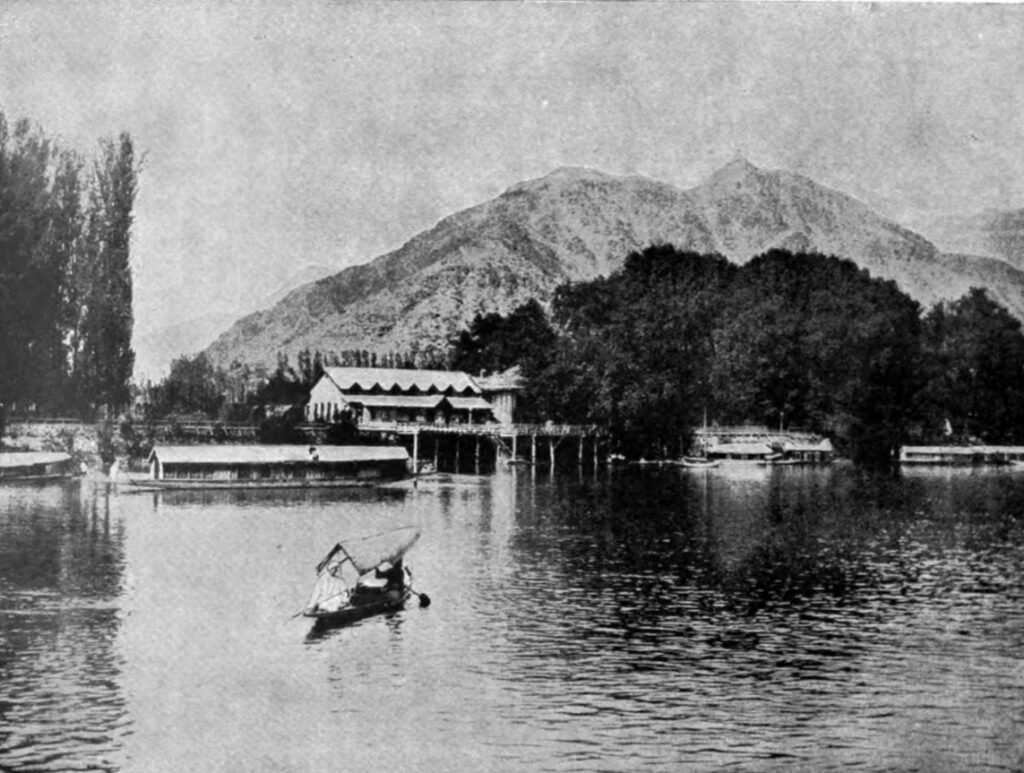
Mentioning Iqbal’s connections with the Ahrar, Chaudhry Afzal Haq wrote:
“‘Allama Sir Muhammad Iqbal was mentally an Ahrar.’ He would see danger for Islam within the aims of” Ahmadis. “Since the beginning, he believed that the” Ahmadis “are enemies of Islam, and would never adore them. Mirza Bashir-ud-Din[ra] was the president of the Kashmir Committee. Although he [Iqbal] was certainly a member, this situation was inevitable [for him]. Very soon, he recovered and began to [internally] destroy the Kashmir Committee. Moreover, he went on to encourage the organisation of Ahrar.” (Tarikh-e-Ahrar, Maktaba-e-Majlis Ahrar-e-Islam Pakistan, 1968, p. 196)
Ravinderjit Kaur states that “Mirza Sahib[ra] agreed to resign the presidentship of the Kashmir Committee on the condition that Ahrars should work in cooperation with [the] general Muslim public and in accordance with the wishes of the majority they should daily submit the accounts. The Ahrars refused to accept this offer.” (Political Awakening in Kashmir, APH Publishing Corporation, New Delhi, 1996, p. 179)
It is “a matter of regret that Mirza Bashir-ud-Din Mahmud Ahmad[ra] should have retired, as I understand he has, from the Presidentship of the Kashmir Committee, where his counsels were always those of moderation and prudence. Quietly, but nonetheless with determination, he fought the battle of the Muslims of Kashmir. It was due to his efforts very largely that the important right of peasant proprietorship was conceded to the Muslim agriculturists of Kashmir and Jammu, that lawyers were sent who defended something like two thousand cases arising out of the riots free of charge—and, I think, not least important of all—he combatted the mischievous Ahrar influence.” (The Civil and Military Gazette, 15 May 1933, p. 3)
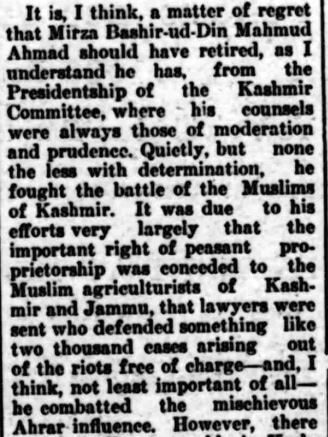
Dr Mohammad Iqbal Chawla, states:
“According to the Ahrar sources, the Ahrar leaders discussed this matter with Allama Iqbal, who allowed them to launch their separate committee to solve the problems of the Kashmiri Muslims.” (“Role of the Majlis-i-Ahrar-Islam Hind in the Kashmir Movement of 1931”, Pakistaniaat: A Journal of Pakistan Studies, Vol. 3, No. 2 (2011), p. 92)
Ahrar leaders such as “Choudhury Afzal Haq and Ataullah Shah Bukhari held a series of meetings with Iqbal and urged him to ditch Bashiruddin[ra]” and “Iqbal obediently agreed to let the Ahrars assume direction of the Kashmiri agitation.” (Self and Sovereignty: Individual and Community in South Asian Islam Since 1850, Routledge, 2000, p. 364)
On 24 to 28 August 1933, Ahrar leaders convened in Lahore and passed a resolution in which they celebrated their hollow “victory” and said that the Kashmir Committee had become purely an “Islamic party”. (Karwan-e-Ahrar, Vol. 1, 1975, Maktabah Tabsarah, Lahore, p. 362)
The demand to exclude Ahmadis from the Muslim community was “brought to a boil by the Ahrars seeking to avenge their failure to outshine everyone else in the contest to incorporate Kashmir into a larger Muslim whole.” The Ahrar succeeded in convincing Iqbal to demand the exclusion of Ahmadis from the Muslim community, the same Iqbal who, prior to 1935, not only “considered the Ahmadis a sect within Islam,” but also praised its Founder, Hazrat Mirza Ghulam Ahmadas. (Self and Sovereignty: Individual and Community in South Asian Islam Since 1850, Routledge, 2000, pp. 365-366)
Allama Muhammad Iqbal had clearly declared Hazrat Mirza Ghulam Ahmadas of Qadian to be “The profoundest theologian among modern Indian Muhammadans.” (The Indian Antiquary, A Journal of Oriental Research, 1900, Vol. XXIX, p. 239)
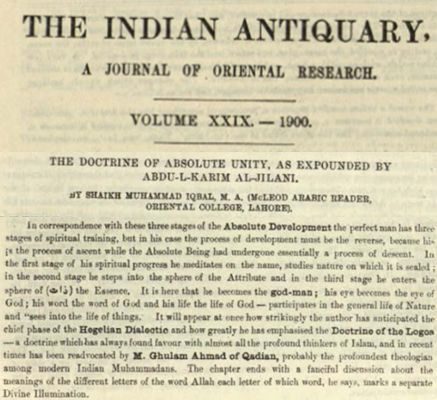
This whole episode and its unfavourable impact on Kashmiri Muslims was beautifully summarised by a political Muslim correspondent of The Civil and Military Gazette:
“The bulk of the Kashmiri Muslims themselves have no use for the Ahrars,” and “there can be no doubt from a practical point of view that the replacement of the Ahmadiyya influence on the Committee by that of the Ahrars is most deplorable in the public interests.” (The Civil and Military Gazette, 9 July 1933, p. 3)
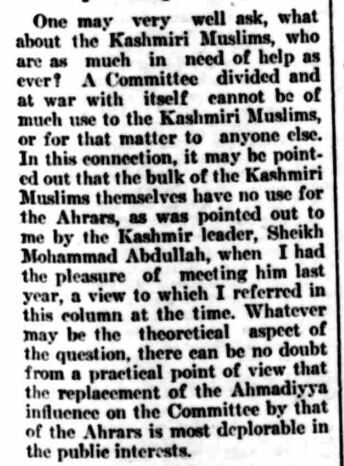
Ahrar office in Qadian
In March 1934, Majlis-e-Ahrar opened their office in Qadian, and on the invitation of Majlis-e-Ahrar Qadian, the president of the All-India Majlis-e-Ahrar Maulvi Habib-ur-Rahman Ludhianvi visited Qadian on 23 March 1934. Upon his arrival, the Ahraris who accompanied him raised anti-Ahmadiyya slogans and used abusive language. This was followed by a jalsa, which was addressed by Habib-ur-Rahman Ludhianvi, who used vile language against the Promised Messiahas and Hazrat Khalifatul Masih IIra. He said that the British had raised Ahmadiyyat as a “fitna within Islam”, and asked his followers, “O Muslims of Qadian! It is your duty to efface this ‘fitna’ as soon as possible.” (Karwan-e-Ahrar, Vol. 1, 1975, Maktabah Tabsarah, Lahore, pp. 426-430)
According to Chaudhry Afzal Haq, the Ahrar office in Qadian was established through a certain Maulvi Inayatullah, and thereafter, Ahrar began to send their volunteers to Qadian to offer prayers at the non-Ahmadi mosques there. (Tarikh-e-Ahrar, Maktaba-e-Majlis Ahrar-e-Islam Pakistan, 1968, pp. 182-183)
Ahrar’s aim was to tempt the local Ahmadis into some kind of dispute with those volunteers in order to cause disorder. Implementing their agenda, they would use vile language against the Jamaat and the Promised Messiahas during gatherings at those mosques. They also initiated a series of anti-Ahmadiyya jalsas in various cities and during one such jalsa in Amritsar, Maulvi Habib-ur-Rahman Ludhianvi announced that Majlis-e-Ahrar “has now laid its foundations in Qadian,” and has made “a firm pledge to destroy” Ahmadis. “You ought to organise yourselves and strengthen your political power in order to compete with them.” (Al Fazl, 29 March 1934, p. 10)
Ahrar and Hazrat Sir Zafrulla Khanra
Ahrar opened up another front in their anti-Ahmadiyya agitation, in the shape of their opposition to the appointment of Hazrat Sir Chaudhry Muhammad Zafrulla Khanra as a member of the Viceroy’s Executive Council:
“Unable to resolve their internal dilemmas, the Ahrars turned to flushing out those they disapproved of in the Muslim community. Fazl-i-Husain was first to come under attack for recommending a learned and capable Ahmadi, Choudhury Zafrullah Khan[ra], as his temporary replacement on the viceroy’s executive council. Sections of the Punjab press led by the Zamindar and others in the Ahrar mould accused the Unionist leader for patronizing Ahmadi ‘infidels’ over ‘true’ Muslims like Muhammad Iqbal.” Iqbal was “evidently disappointed at being passed over for the highest office an Indian could occupy in the colonial system.” (Self and Sovereignty: Individual and Community in South Asian Islam Since 1850, Routledge, 2000, p. 364)
The Civil and Military Gazette reported on 22 September 1934:
“The most determined attempt is being made to whip up opposition to the Chaudhri Sahib’s appointment, and packed meetings are passing hole-and-corner resolutions in the name of the Muslim Community, and sending copies of them to the Viceroy, the Secretary of State, the Premier, and heaven knows whom.
“Factious Opposition
“The ostensible ground for this opposition is religious, namely that the Chaudhri Sahib belongs to the sect of the Ahmadiyyas of Qadian, whose loyalty to the Government, much more than any peculiarity in their theology, has rendered them unpopular in certain quarters. That this is so will be evident on consideration of the quarters whence the opposition comes — the discredited, but now resurgent Majlis-i-Ahrar, and the Congressite Muslims of the school of Mr. Zafar Ali Khan of the Zemindar. […] Since they could not attack him on political grounds, they have brought up his theology against him.”
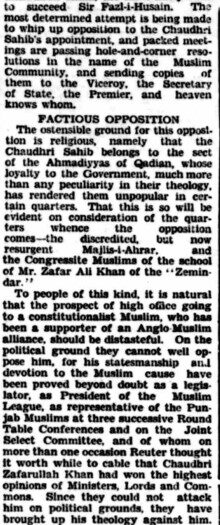
Janbaz Mirza, official historian of Ahrar, states that Sir Mian Fazl-i-Husain “desired to elect Sir Zafrulla as his successor at the Viceroy’s Executive Council. As the guardian of the British interest, Sir Fazl-i-Husain was at the top of the list in Punjab; thus, upon his proposal, the Viceroy accepted to take Sir Zafrulla Khan into his Council.
“Meanwhile, when the news came to the Majlis-e-Ahrar that Sir Zafrulla was being granted representation in the Viceroy’s Executive Council as a Muslim representative, it caused great concern. Resolutions were passed all over the country, [and] protests were carried out saying that this seat is reserved for a Muslim and should be given to a Muslim. However, neither Sir Fazl-i-Husain had a second thought on this proposal, nor did the English Government deem it appropriate to ponder over it. In this regard, a deputation of Ahrar met the Viceroy, which included Maulana Habib-ur-Rahman Ludhianvi, Mir Ahmad Hussain and the lawyer of the Shimla and Allahabad High Court, Mr Muhammad Ahmad Kazmi. The Viceroy responded to the deputation:
“‘You do not consider Zafrulla Khan to be a Muslim; however, he has been elected through the Muslim votes.’ […]
“At last, through the official announcement in the newspapers on 10 October 1934, Chaudhry Sir Zafrulla Khan was appointed as a member of the Viceroy’s Executive Council.” (Karwan-e-Ahrar, Vol. 2, Maktaba Tabsarah Lahore, 1977, pp. 79-80)
When Mian Fazl-i-Husain “retired from the membership of the Indian Government [Viceroy’s Executive Council], Chaudhry Zafrulla Khan was appointed [in his place]. Upon this, ‘Zamindar’ and Ahraris made a great hue that Mian Fazl-i-Husain is favouring the” Ahmadis. “Many letters were sent to the Viceroy, stating that ‘You have appointed a “non-Muslim” to fill the vacancy of a Muslim. Remove Zafrulla Khan and appoint any other Muslim in his place.’” (Yaran-e-Kuhn, Abdul Majeed Salik, Matbu‘at-e-Chitan, pp. 87-88)
Ahrar Conference near Qadian
Majlis-e-Ahrar had planned to hold a conference in Qadian on 20-22 October 1934, and the government made precautionary measures to prevent any disorder. The correspondent of The Civil and Military Gazette reported that he visited Qadian on 13 October, “in order to inspect the preparations which are being made by the Ahrars for the conference they have advertised for October 20 to 22 and found that considerable interest was being taken by the Ahmediyas, who view with apprehension a possibility of trouble brewing between the Ahrar party and themselves.” (The Civil and Military Gazette, 19 October 1934, p. 7)
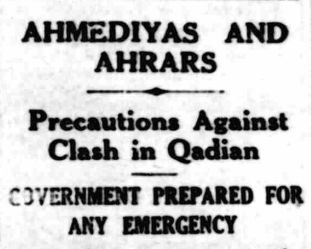
Chaudhry Afzal Haq states, “We announced to hold the ‘Ahrar Tabligh Conference’ in Qadian to defy the claims of Qadian’s sanctity.” (Tarikh-e-Ahrar, Maktaba-e-Majlis Ahrar-e-Islam Pakistan, 1968, pp. 183-184)
During these turbulent times, after receiving divine guidance, Hazrat Musleh-e-Maudra had intended to announce a scheme to propagate the message of Islam all around the world. However, before announcing the details of this scheme, during his Friday Sermon on 19 October 1934, Huzoorra informed the Jamaat about the upcoming Ahrar Conference and its mischievous objectives. Huzoorra advised Ahmadis “not to raise their hand against anyone, even if they are beaten,” and “even if they are about to be murdered, they do not have the right to lift their hand or open their mouth.” (“Tahrik-e-Jadid: The magnum opus of Hazrat Musleh-e-Maud – Part 1”, Al Hakam, 30 October 2020, Issue 137, p. 4)
The Civil and Military Gazette, on 25 October 1934, claimed that “no inflammatory speeches were made” during the Ahrar Conference. However, the truth was that the Ahrar jalsa was full of hateful and inflammatory speeches against Ahmadiyyat. Despite all these hateful speeches, Ahmadis remained peaceful and did not indulge in any violence.
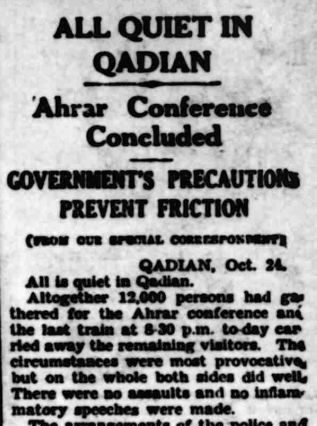
Tahir Kamran, a notable historian from Pakistan, writes that “the Ahrar held a tabligh conference on the outskirts of Qadian,” where Ata Ullah Shah Bukhari “overstepped the mark in expressing his hatred of the Ahmadis.” (“The Pre-History of Religious Exclusionism in Contemporary Pakistan: ‘Khatam-e-Nubuwwat’ 1889–1953.” Modern Asian Studies 49, no. 6 (2015): 1840–74. www.jstor.org/stable/24734820.)
During his hateful speech against Ahmadiyyat, Attaullah Shah Bukhari used very abusive language against the Promised Messiahas, and while challenging Ahmadiyyat, he said, “This is Majlis-e-Ahrar. It will tear you into pieces.” (Tarikh-e-Ahrar, Maktaba-e-Majlis Ahrar-e-Islam Pakistan, 1968, p. 192)
The Munir Inquiry Report states:
“One of the main activities of the Ahrar was their opposition, in one form or another, of the Ahmadis. It may indeed be said that the Ahrar took their birth in the hatred of the Ahmadis. […] In 1934, the Ahrar decided to hold a conference in Qadian itself but on the meeting having been banned, they held the conference on 2lst October of that year in the playground of the Dayanand Anglo-Vedic High School in Rajada, a village only a mile away from Qadian, where they attracted an audience of many thousands. In that conference the popular Ahrar speaker Sayyad Ata Ullah Shah Bukhari delivered a 5-hour diatribe against the Ahmadis in the course of which he said ‘things which could have no other effect but to rouse hatred of the Ahmadis in the minds of the hearers’, the professions of peace in his speech alternating with abuse and wit of a very low order.” (Report of the Court of Inquiry constituted under Punjab Act II of 1954 to enquire into the Punjab Disturbances of 1953, 1954, p. 12)
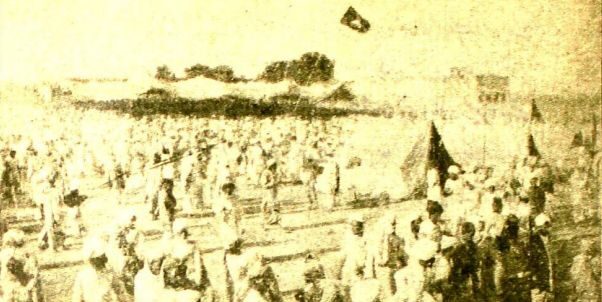
Tahrik-e-Jadid’s announcement in a series of Friday Sermons
During his Friday sermon on 26 October 1934, Hazrat Musleh-e-Maudra commended the patience shown by Ahmadis in spite of the provocative acts by the Ahrar during the conference. Huzoorra informed members of the Jamaat about the tense situation created by the Ahrar, and said, “There is opposition from all sides, and it is your duty to uphold the dignity of the Jamaat while confronting it” and to “make whatever sacrifices you must make.” (“Tahrik-e-Jadid: The magnum opus of Hazrat Musleh-e-Maud – Part 1”, Al Hakam, 30 October 2020, Issue 137, p. 5)
During his next Friday Sermon, Huzoorra elaborated on the tribulations created by the Ahrar against the Jamaat and the unjust attitudes of some government officials. (Ibid.)
In his Friday Sermon on 9 November 1934, Huzoorra stated that at the time, religious and political parties were gathering against the Ahmadiyya Muslim Jamaat and people of all religions were against this Community – not just people of one religion. Huzoorra said that after constantly praying to Allah the Almighty and after seeing a divine vision, he had prepared a scheme, which he would start outlining the following Friday. (Ibid, Part 2, Al Hakam, 6 November 2020, Issue 138, p. 10)
In his book, Tarikh-e-Ahrar, Chaudhry Afzal Haq has made the false assertion that Hazrat Mirza Bashir-ud-Din Mahmud Ahmadra had told the Ahmadis that Ahrar was the only hurdle in the way of Ahmadiyyat’s progress, and if they were defeated, Ahmadis should consider it a great victory. (Tarikh-e-Ahrar, Maktaba-e-Majlis Ahrar-e-Islam Pakistan, 1968, p. 202)
However, the fact is that Hazrat Musleh-e-Maudra advised Ahmadis that they ought not to consider the Ahrar agitation as the biggest hurdle in their way, but to be prepared for bigger and more dangerous trials. During his Friday Sermon on 16 November 1934, Huzoorra said:
“Greater trials are yet to come before the Jamaat,” and Ahmadis must realise that these hardships are “a prelude to great battles, and there are even greater trials than this to come which will be faced by the Jamaat. We are not to spread Ahmadiyyat in any one city or country, but it is to be promulgated to the whole world. So, while our goal is to compete with the whole world, how could we assume that we can easily conquer the whole world after overcoming Chaudhry Afzal Haq Sahib of Lahore, Maulvi Mazhar Ali Sahib, Ataullah Sahib Bukhari, and Maulvi Zafar Ali Sahib and their friends?” (“Tahrik-e-Jadid: The magnum opus of Hazrat Musleh-e-Maud – Part 2”, Al Hakam, 6 November 2020, Issue 138, p. 11)
Huzoorra explained that the ongoing trouble against Jamaat-e-Ahmadiyya was religious, economic and political at the same time. The people may despise us, but the Jamaat does not have enmity for anyone. The Jamaat is a well-wisher for Muslims and Hindus alike; in fact, the Jamaat wishes everyone well. (Ibid)
During his Friday Sermons on 23 and 30 November 1934, Huzoorra outlined the details of the Tahrik-e-Jadid scheme in the shape of nineteen demands. (Ibid., Part 2 and 3, Al Hakam, 6 and 13 November 2020, Issue 138 and 139)
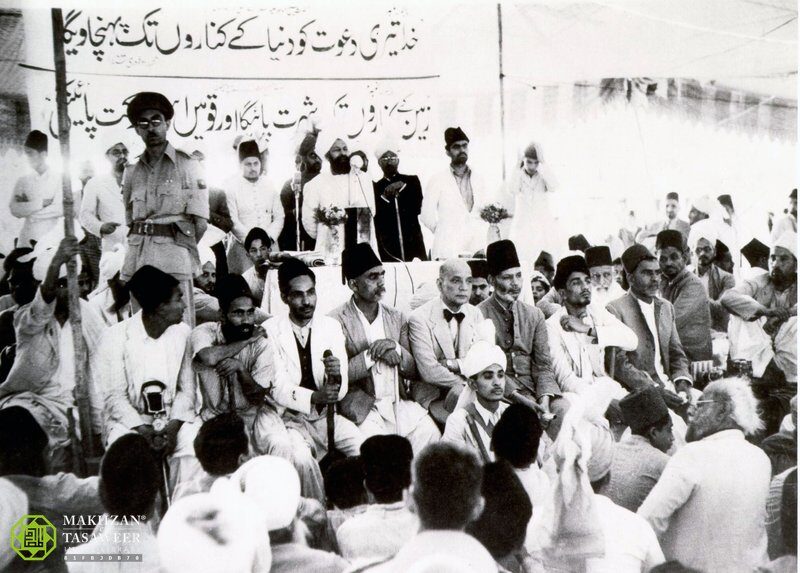
On 30 November 1934, the Chief Secretary to the Government of Punjab wrote to the Secretary to the Government of India (Home Department), and stated:
“I am directed to report, for the information of the Government of India, that the Governor-in-Council has sanctioned the prosecution under section 153-A, Indian Penal Code, of Syed Ata Ullah Shah Bokhari, Son of Zia Ullah Shah, resident of Amritsar, in respect of an anti-Ahmadiya speech delivered by him at a public meeting held under the auspices of the ‘Shoba-i-Tabligh’ of the Majlis-i-Ahrar-i-Hind at Qadian on the 21st October, 1934, as the speech in question, of which a full translation is enclosed, is calculated to promote feelings of enmity and hatred between Ahmadiyas and other Muhammadans.
“Syed Ata Ullah Shah Bokhari is an ex-convict under Section 124-A, Indian Penal Code, and is the moving spirit of the Shoba-i-Tabligh of the Anjuman-i-Ahrar-i-Islam-i-Hind, which was responsible for the Ahrar Conference at Qadian on the 21st-23rd Octr., 1934.” (National Archives of India, Government of India: Home Department [Political], File No. 36-II/34-Poll.)
Hazrat Musleh-e-Maud’sra speech at Jalsa Qadian
During his inaugural speech at the Jalsa Salana 1934, Hazrat Musleh-e-Maudra mentioned various glad tidings of God Almighty which were granted to the Promised Messiahas, for instance:
میں تیری تبلیغ کو زمین کے کناروں تک پہنچاؤں گا۔
“I shall carry your message to the ends of the earth.” (Tadhkirah [English], p. 407)
Huzoorra continued:
“Nowadays, some people proclaim, ‘We will efface Ahmadiyyat’, others claim that ‘We have effaced Ahmadiyyat’, and certain individuals write ‘Fatih-e-Qadian’ [conqueror of Qadian] along with their names as well. However, every sane and wise person witnesses and understands that neither any ‘conqueror of Qadian’ has ever been born nor will ever be born, but rather, it is Qadian that is [spiritually] conquering the world. […] No other sect is being opposed as much as opposition has been carried out against Jamaat-e-Ahmadiyya, and is still continuing; however, Jamaat-e-Ahmadiyya has continued to flourish, is still growing, and will continue to do so. […]
“Satan will leave no stone unturned to attack along with all of its ‘armies’, however, this Community will flourish, it will flourish, and it will surely flourish. At last, the ones who have stood to efface it, will themselves be effaced. The world would witness every town of the world as the manifestation of Qadian, meaning, Ahmadis will be victorious in every town of the world, and they would exceed the others in numbers. […] Thus, I call the attention of the members that they should benefit from whichever opportunity they get to make a sacrifice, with sincerity, love, courage and steadfastness, so that God Almighty showers His special grace and blessings, and may we reach such level of progress which is essential for us to attain.” (Iftitahi Taqrir Jalsa Salana 1934, Anwar-ul-Ulum, Vol. 13, pp. 310-312)
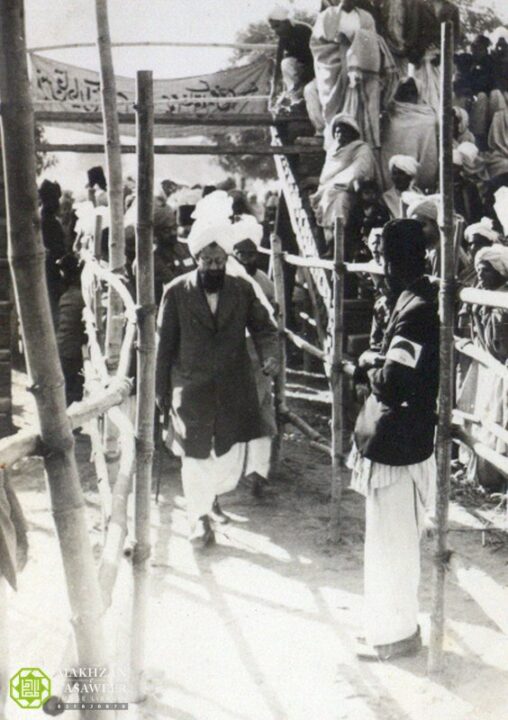
Who was serving Islam?
On one hand, Ahmadiyyat had been serving to propagate the beautiful teachings of Islam for a half-century or so, and its Imam, Hazrat Mirza Bashir-ud-Din Mahmud Ahmadra, had recently launched the grand scheme of Tahrik-e-Jadid to enhance this endeavour, one must ponder what Ahrar were doing. In this regard, Chaudhry Afzal Haq stated during a speech at the Ahrar Tabligh Conference in Delhi in April 1941:
“I have heard the beauties and hallmarks of Islam being narrated during hundreds of speeches, however, I have not heard any Ahrar leader advising the Muslims to fulfil their religious and tablighi duties and to present the gift of Islam to the non-Muslims.” (Khutbat-e-Ahrar, Vol. 1, compiled by Agha Shorish Kashmiri, Maktaba-e-Ahrar, Lahore, 1944, p. 74)
Ahrar’s strategy: ‘Appealing to mob psychology’
On 9 January 1935, The Civil and Military Gazette published a certain Muslim’s ‘Letter to the Editor’, which stated:
“The Ahrar leaders” have “adopted a new course to win the favour of the Muslim masses by appealing to mob psychology. Today their whole attention is engaged in trying to discredit the Ahmadiyya community. […] It is sad that the Ahrars should be doing a great harm to the Muslim cause as a whole—harm that will lead to terrible consequence; for Muslim India. Let this be a timely warning to the Ahrars lest it should be too late.” The Ahrar “want to discard the members of the same creed, demanding from the Government that the Ahmadies should be treated as a separate minority. This will be a great blow to the Muslims, for even at present they exist as a poor minority, and with the departure of the Ahmadies they will be left poorer still. […] It remains the greatest tragedy of Indian Muslims, who still continue to be a backward community. Will the Ahrar leaders ponder over this vital point and exercise a measure of tolerance with regard to the Ahmadi problem?”
Governor’s letter
The then Governor of Punjab Sir Herbert William Emerson wrote to the then Viceroy of India Lord Linlithgow, on 19 October 1936, and mentioned the Ahrar’s anti-Ahmadiyya agitation. He stated:
“For some years Ahrars have been carrying on a most virulent campaign against the Ahmadis of Qadian, and especially against the present head of the community. In this campaign they had the sympathy of a large number of orthodox Muslims, and for some time the situation was one of great potential danger. It looked as if there might be a very widespread Muslim movement against the Ahmadis, and that it would be difficult for [the] Government to protect the latter. The Ahrars had found a popular platform; they were entirely unscrupulous in making the best use of it; and by raising the cry of ‘Danger to Islam’ they were fast increasing their strength.” (Punjab Politics, 1936-1939: The Start of Provincial Autonomy [Governor’s Fortnightly Reports and other Key Documents], Lionel Carter (ed.), Manohar, 2004, p. 51)
Further in this letter, he wrote:
“They are anti-Government and have flirted with Congress from time to time. They have no outstanding leaders of position, but have several good mob orators.” (Ibid.)
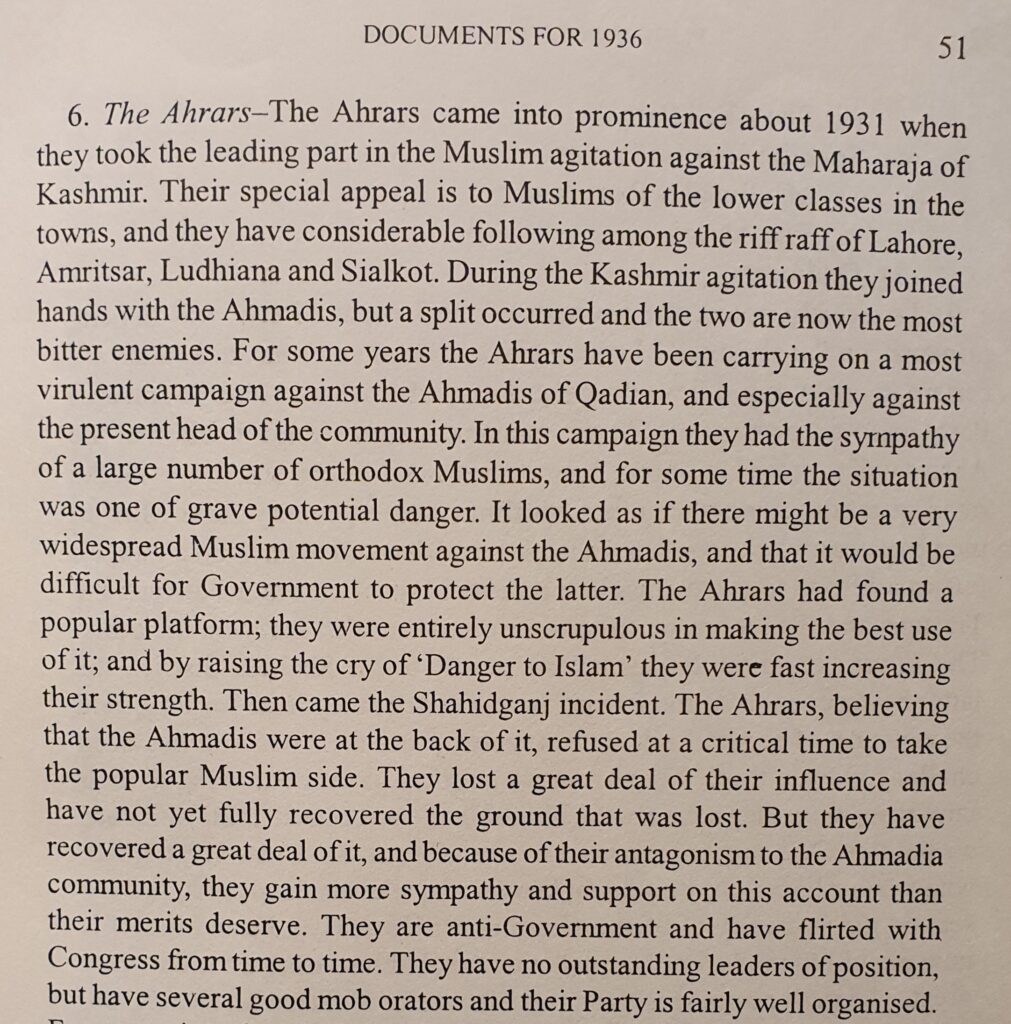
All-India National League
The Ahrar were continuously intensifying their anti-Ahmadiyya campaign, and the Jamaat was calling the attention of the Government to realise the severity of the situation. However, despite all these efforts, the Government was not only failing to eradicate these mischievous acts of the Ahrar, rather, some of the members of the Punjab Government were apparently supporting Ahrar in some form or another. Hence, on 25 January 1935, an organisation named “All-India National League” was formed with the aim of safeguarding the rights of the Ahmadiyya Muslim Jamaat and informing the Government about the true facts of the prevailing circumstances, so they could take the necessary actions.
Section 144 in Qadian
Due to the chaotic situation created by the Ahrar, the District Magistrate of Gurdaspur announced on 30 January 1935, the implementation of Section 144 in Qadian, for two months, under the Criminal Procedure Code. This step hugely impacted the daily routine life of the residents of Qadian and limited their movements and work to a great extent.
An article by The Civil and Military Gazette
The Civil and Military Gazette published a lengthy article on 9 February 1935, under the heading “Unrest at Qadian, Khalifa’s Statement on Ahmadya-Ahrar Friction”, and stated that one of their correspondents had a conversation with Hazrat Musleh-e-Maudra.
Unfortunately, this article also included certain points which were wrongly attributed to Huzoorra, and some of his words were misquoted. Thus, Huzoorra wrote an article to eradicate the misunderstandings created by this article. Huzoorra stated that since he was well aware of the fact that the interview was being held at night amidst insufficient light, and it would be very difficult for the press correspondent to accurately note down the key points of such a long discussion, thus, Huzoorra had also provided him all the relevant newspapers to later consult with. However, Huzoorra said, the press correspondent still made such huge mistakes while publishing the article. This article of Huzoorra was published in Al Fazl on 12 February 1935.
The Ahrar were continuously attempting to create disorder in Qadian, and while mentioning it, The Civil and Military Gazette stated in the above-mentioned article:
“The Khalifa Sahib described in detail the anti-Ahmadya activities of the Ahrars, who, he said, had been harassing his followers and threatening him with murder. He added that several attempts had been made on his life. The Khalifa Sahib described how a man named Mathews, recently tried on a charge of murder, had confessed in his statement in a court of law that he had listened to Ahrars at Batala and had come to the conclusion that the Khalifa Sahib was ‘an undesirable person and should be killed. With this object in view he went to Qadian, but failed.’ […]
“Recently a boy aged about thirteen was caught by a personal attendant of the Khalifa Sahib with a dagger hidden in his trousers. He was convicted. In another case, a young man went to Qadian with similar intentions but on seeing and hearing the Khalifa Sahib he confessed the object of his visit and declared his faith in him from that day. On Monday last a young Pathan, who gave his name as Sardar Khan of Peshawar, went to Qadian and said that he had gone there to declare his faith in the Khalifa Sahib. His talk gave rise to suspicion and he was handed over to the police, who on investigation, are alleged to have learnt that his real name was Feroz Din, that he belonged to Lahore, and that he had gone there with foul intentions. I have since verified that the police are prosecuting Feroz Din. […]
“During last Christmas week, when the Ahmadyas assembled in thousands to attend their annual conference at Qadian, the Ahraris also mustered strong and they distributed filthy literature amongst men, women and children of the Ahmadyas. This infuriated the latter and some of them approached their Head to take action in this matter. The Khalifa Sahib advised them to remain peaceful […and] they were not to go beyond the laws of the Government and Islam and to act according to the past traditions of their community.” (The Civil and Military Gazette, 9 February 1935, p. 6)
In the following months, the Ahrar continued the anti-Ahmadiyya propaganda, and published inflammatory literature as well:
“Several pamphlets against the Ahmadyas have been proscribed, editors have been warned and searches made in this connection. A prominent leader of the Ahraris, Maulana Sayed Attaullah Shah Bokhari, has been prosecuted, at considerable expenditure to the Government for some of his speeches delivered at Qadian. The fact that the whole of the Ahrar Press is attacking the Government as pro-Ahmadya and that Ahmadyas are not satisfied at the present state of affairs, leads one to believe that the Government is pursuing a middle course of even handed justice.” (Ibid.)

‘Seek help from God’: Guidance to Ahmadis by Huzoorra
On one hand, the Ahrar were leaving no stone unturned to harm Ahmadiyyat, on the other, Hazrat Musleh-e-Maudra was granting valuable guidance to Ahmadis during his various speeches.
During his Friday Sermon on 8 February 1935, Huzoorra advised the members of the Jamaat to endure the ongoing opposition and hardships with patience and prayers, and said that the hardships that are faced by the Divine communities are in fact the prelude to the great victories. (Khutbat-e-Mahmud, Vol. 16, pp. 108-112)
During his Friday Sermon on 22 March 1935, Huzoorra said:
“All communities are determined to oppose and humiliate us, and we have no other way than to reach out to our Lord and to pray: ‘O God, we have been made subject to disrepute, persecution, injustice and hardships without any reason, and we have been disrespected and dishonoured. We do not possess any power to confront the opponents, thus, manifest Your Power, since You are All-Powerful. O King of the kings, manifest Your Kingship. O Master, manifest your Mastership and stop them and help us.’ […]
“We have treated everyone in this world with humbleness and meekness,” and “have repeatedly said that we are not the enemy of anyone, and By God, we are well-wishers of everyone, but our words were discredited, our friendliness was ignored, our claims of obedience [to the rule of law] were made fun of, and it was said that ‘They are rebels.’ […]
“I call the attention of those for whose strength, power and betterment we are striving [Muslims]; we are those who sacrifice lives for the sake of the Holy Prophet Muhammadsa and offer sacrifices for the sake of Faith. Then, I call the attention of the Hindus and Sikhs to the fact that God is a Witness that we are not their enemy, we present to them Islam because we believe that therein lies their salvation. We do not wish for them to be disrespected or disreputed, but rather, we are their well-wishers. Then, I say to the Government that we do not desire any government; we have been born to serve [the nation]. […]
“We ought to seek help from God, but even then, we do not say that God may destroy them; rather, we only pray that He may reform their hearts and correct them. If they do not reform themselves despite being called out, we seek refuge from their evil, and if they reform themselves, may Allah the Almighty have mercy on them.” (Khutbat-e-Mahmud, Vol. 16, pp. 220-221)
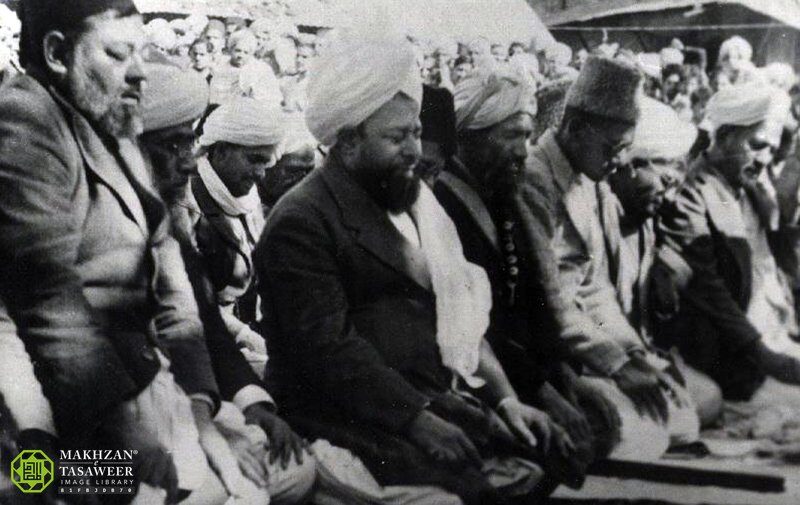
Hazrat Musleh-e-Maudra in Gurdaspur
Towards the end of March 1935, Hazrat Musleh-e-Maudra visited Gurdaspur, to record his statement on the case against Ahrari leader Syed Ataullah Shah Bukhari, for his inflammatory speech at the Ahrar Conference in Qadian.
Huzoorra visited Gurdaspur on 23 March. While the statement was still being recorded, the court session was adjourned for a short break. Huzoorra proceeded to a temporary camp established for Huzoorra and his entourage. After having lunch, Huzoorra led the Zuhr prayer there and proceeded to the courtroom again. While the statement was yet to be completed, the court session was adjourned for 25 March 1935. (Al Hakam, 28 March and 7 April 1935, pp. 5-6)
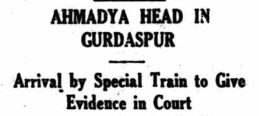
Upon returning to the camp, Huzoorra delivered a short address in which he said that the believers should never get frightened by hardships, and since “it is the practice of Allah the Almighty to make the followers of prophets walk on the thorns [of opposition], we ought to understand that we would also have to endure hardships and trials; however, the ultimate victory is destined for us. You are required to supplicate, seek prayers, and inculcate the love of God Almighty in your hearts.” (Ibid., p. 7)
Reporting about Huzoor’sra statement, The Civil and Military Gazette wrote on 25 March 1935, “Khalifa Bashir-ud-Din Mahmud, head of the Ahmadya community, appeared as a defence witness today [23 March 1935] in a case against Attaullah Shah Bokhari, the Ahrar leader, who is being tried on a charge of promoting hatred between two communities. The case arose out of a speech delivered by the accused at the Ahrar Conference in last October in Qadian. […] The evidence of the Khalifa had not concluded when the hearing adjourned to Monday.”
On 25 March 1935, Huzoorra went to Gurdaspur again via a special train to continue his statement in the court. Huzoorra continued his statement, and then the court session was adjourned for a short break. Huzoorra proceeded to the camp, where he delivered a short speech, in which he advised the Jamaat to endure with patience and prayers. Huzoorra said that Divine communities are decreed to face severe opposition, however, they ultimately overpower their opponents. (Ahmadiyyat Destiny and Progress, pp. 27-32)
Hazrat Musleh-e-Maud’sra special message
On 30 March 1935, Hazrat Musleh-e-Maudra issued a special message for the members of the Jamaat, in which he advised the Jamaat “to control their emotions, to remain silent even if they are beaten, and to not care even if they are abused. On the contrary, with patience and endurance, they are required to fail the efforts that are being exerted to malign the Jamaat by the Ahrar and the officials who are backing them. […] God Almighty will soon manifest His Power, and will fail the opponents in their plans, and will manifest the innocence of our Jamaat and that we are being oppressed.” (Al Hakam, 28 March and 7 April 1935, p. 1)
Section 144 declared invalid
On 2 April 1935, the Lahore High Court issued a ruling against the implementation of Section 144 in Qadian:
“The restrictions which were imposed upon the residents of Qadian by the District Magistrate of Gurdaspur under Section 144 of the Criminal Procedure Code and which remained in force from January 30 to March 30 last were invalid, according to a judgment delivered by Mr Justice Currie of the Lahore High Court on Tuesday.” (The Civil and Military Gazette, 3 April 1935, p. 6)
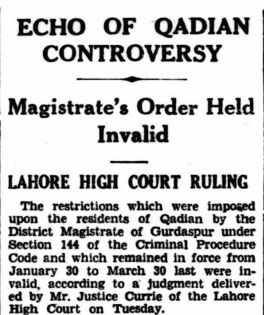
Ahrar Conference in Lahore
On 19-21 April 1935, the Ahrar held a conference in Lahore, where they “congratulated Bahawalpur on the judgment of a District Judge declaring the” Ahmadis “‘to be outside the pale of Islam’” and “opposed the appointment of Chowdhry Zafrullah Khan to the Executive Council.” (The Civil and Military Gazette, 23 April 1935, p. 8)
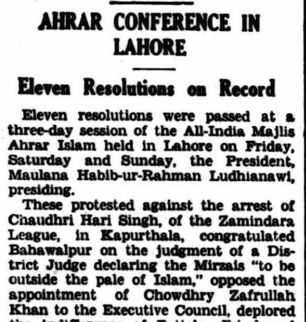
Judgement on Bukhari’s case
On 25 April 1935, the Magistrate Court in Gurdaspur announced its verdict on the case against Ataullah Shah Bukhari:
“The trial of the Ahrar leader, Syed Ata Ullah Shah Bukhari, in the court of a Gurdaspur Magistrate on a charge of creating hatred between two classes of His Majesty’s subjects, ended on Thursday and resulted in a conviction. The accused was awarded six months’ imprisonment and recommended to be treated as a ‘B’ class prisoner. The case, which created considerable interest among Punjab Muslims, arose from a speech delivered by the accused at an Ahrar conference in Qadian about six months ago. The object of the conference was religious propaganda against the tenets of the Qadiani sect of Muslims.” (The Civil and Military Gazette, 26 April 1935, p. 6)


